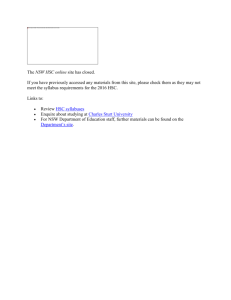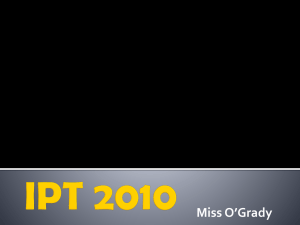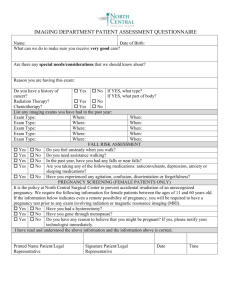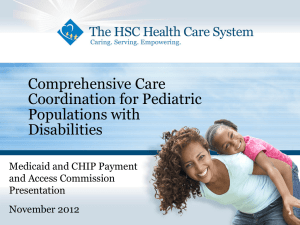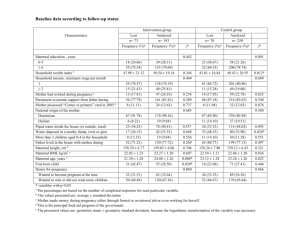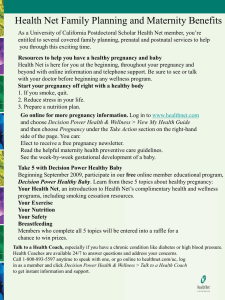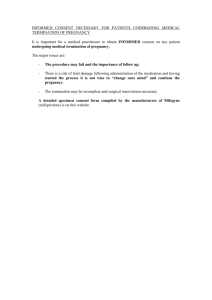Title: Maternal health and pregnancy outcomes among women of
advertisement
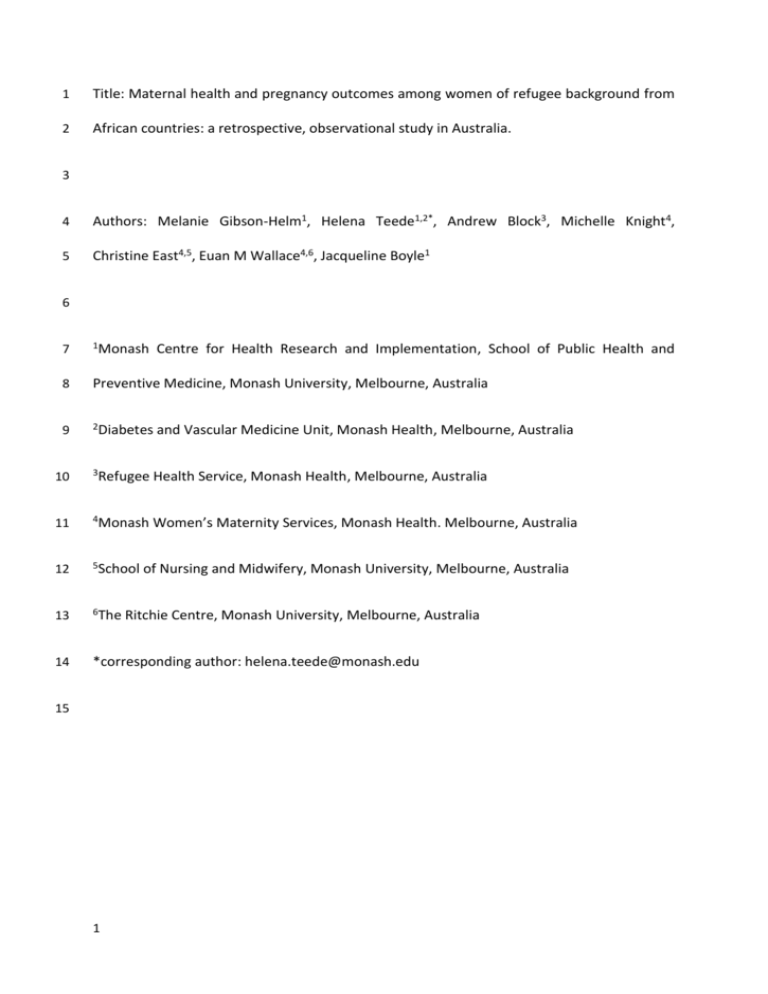
1 Title: Maternal health and pregnancy outcomes among women of refugee background from 2 African countries: a retrospective, observational study in Australia. 3 4 Authors: Melanie Gibson-Helm1, Helena Teede1,2*, Andrew Block3, Michelle Knight4, 5 Christine East4,5, Euan M Wallace4,6, Jacqueline Boyle1 6 7 1Monash 8 Preventive Medicine, Monash University, Melbourne, Australia 9 2Diabetes Centre for Health Research and Implementation, School of Public Health and and Vascular Medicine Unit, Monash Health, Melbourne, Australia 10 3Refugee Health Service, Monash Health, Melbourne, Australia 11 4Monash Women’s Maternity Services, Monash Health. Melbourne, Australia 12 5School 13 6The 14 *corresponding author: helena.teede@monash.edu 15 1 of Nursing and Midwifery, Monash University, Melbourne, Australia Ritchie Centre, Monash University, Melbourne, Australia 16 Abstract 17 Background: Women of refugee background from Africa are reported to have a greater risk 18 of adverse pregnancy outcomes compared to women born in resettlement countries. 19 However, there is currently little insight into whether adverse pregnancy outcomes are 20 more common among migrant women of refugee background, compared to women who 21 have migrated for non-humanitarian reasons. To inform whether women of refugee 22 background require additional services in pregnancy compared to non-refugee migrant 23 women from similar world regions we aimed to describe and compare maternal health, 24 pregnancy care attendance and pregnancy outcomes among migrant women from Africa 25 with or without a refugee background. 26 Methods: Retrospective, observational study of singleton births at a single, metropolitan, 27 maternity service in Australia 2002-2011, to women born in humanitarian source countries 28 (HSC) and non-HSC from North Africa (n=1361), Middle and East Africa (n=706) and West 29 Africa (n=106). 30 Results: Compared to non-HSC groups, age<20 years (0-1.4% vs 2.3-13.3%), living in 31 relatively socio-economically disadvantaged geographic areas (26.2-37.3% vs 52.9-77.8%) 32 and interpreter need (0-23.9% vs 9.7-51.5%) were generally more common in the HSC 33 groups. Compared to non-HSC groups, female genital mutilation (0.3-3.3% vs 5.1-13.8%), 34 vitamin D insufficiency (8.7-21.5% vs 23.3-32.0%), syphilis (0-0.3% vs 1.2-7.5%) and hepatitis 35 B (0-1.1% vs 1.2-18%) were also generally more common among the HSC groups. Unplanned 36 birth before arrival at the hospital (3.6%) was particularly high in the North African HSC 37 group. HSC-birth was associated with gestational diabetes mellitus (odds ratio=3.5, 95% 38 confidence interval: 1.8-7.1) among women from Middle and East Africa, after adjusting for 2 39 maternal age, parity, body mass index and relative socio-economic disadvantage of area of 40 residence. The West African HSC group had the highest stillbirth incidence (4.4%). 41 Conclusions: Migrant women of refugee background from different African regions appear 42 to be at greater risk of specific adverse pregnancy outcomes compared to migrant women 43 without a refugee background. Awareness of differing risks and health needs would assist 44 provision of appropriate pregnancy care to improve the health of African women and their 45 babies. 46 47 Key words: refugee, Africa, pregnancy, birth, pregnancy care, maternal health, migrant, 48 antenatal, obstetric outcomes, perinatal. 3 49 Background 50 For the last decade Africa has been a key focus of humanitarian migration programs 51 internationally [1, 2]. Compared to women born in resettlement countries, women of 52 refugee background in general [3, 4], and women from African humanitarian source 53 countries specifically [5, 6], are reported to have greater risks of adverse pregnancy 54 outcomes such as stillbirth [3, 6], perinatal mortality [3-5] and caesarean section [6]. A 55 number of studies have also reported greater risks of adverse pregnancy outcomes among 56 migrant women in general from African countries, compared to women born in 57 resettlement countries including stillbirth [7, 8], perinatal mortality [9-11], caesarean 58 section [11, 12], preterm birth [10, 12] and low birth weight [11, 12]. Previous research has 59 concluded that the relationship between migration and pregnancy outcomes varies with 60 migrant subgroup (defined by race/ethnicity or world region of origin), and resettlement 61 country [13]; however, there is currently little insight into the impact of refugee background 62 over and above that of migrant background among women from Africa. Comparing 63 pregnancy outcomes between migrant women of refugee and non-refugee background 64 from similar world regions enables exploration of whether women of refugee background 65 are at additional risk of adverse outcomes and require pregnancy services different to those 66 for women who have migrated for non-humanitarian reasons. 67 Interpreting pregnancy outcomes for a heterogeneous migrant population may be limited 68 by possible bias due to differences between women that are often undetectable in routine 69 clinical datasets (e.g. cultural beliefs, dietary habits or genetic background). For example, 70 female genital mutilation (FGM) is a risk factor for adverse pregnancy outcomes that varies 71 in prevalence and severity between African regions [14]. Investigating maternal health and 4 72 pregnancy outcomes in regional subgroups of women may identify needs specific to 73 particular groups of resettled refugees. 74 Accordingly, we aimed to report maternal health, pregnancy care attendance and pregnancy 75 outcomes among three cohorts of women born in African humanitarian source countries 76 (HSC) compared to women born in African non-HSC, at one of Australia’s largest health 77 services. 78 79 Methods 80 Women of refugee background may come to Australia after being granted a visa overseas 81 through the Humanitarian Migration Program, by boat or plane and applying for asylum 82 after arrival, or through the Family or Skilled Migration Programs (having gained a non- 83 humanitarian visa but being of refugee background) [15]. Generally, between 10,000 and 84 15,000 people per year have arrived in Australia through the Humanitarian Program since 85 1985 [1]; the four countries of birth that contributed the most arrivals through the 86 Humanitarian Program between 2002 and 2011 were Sudan, Afghanistan, Iraq and Burma 87 [16]. The local government areas of Greater Dandenong and Casey (served by Monash 88 Health) continue to be major areas of refugee resettlement receiving more than 25% of 89 Victoria’s approximately 14,200 Humanitarian Program arrivals in 2010-2013 [15]. 90 Monash Health is the largest public health service and the largest maternity provider in 91 Victoria, providing maternity care across three hospitals in Melbourne’s south-east. 92 Between 2002 and 2011 there were approximately 6,500 births each year at Monash Health 93 and half of the women giving birth there were born overseas. 5 94 Routinely collected data from clinical care can make valuable contributions to medical 95 research, but the selection of data fields for collection impacts on the options available to 96 researchers [17]. In this study dataset, country of birth was the only routinely collected data 97 field that could act as an indicator of possible refugee background. Taking this into account, 98 we used national immigration data [16] for 2002-2011 to identify African countries of birth 99 from where two thirds or more of the total immigrants had entered Australia within the 100 humanitarian stream (HSC) and countries of birth from where only one third or fewer had 101 entered within the humanitarian stream (non-HSC). 102 All women receiving free (government funded), universal healthcare with a singleton 103 pregnancy and giving birth at Monash Health between 2002 and 2011 were selected if their 104 country of birth was in the African HSC category. From each United Nations-defined African 105 region [18] represented in the HSC group, all countries of birth in the non-HSC category 106 were also selected from the Monash Health data to form a comparison (control) group. 107 Data were extracted from the Birthing Outcomes System, an electronic database recording 108 all births (liveborn or stillborn) of ≥20 weeks gestation. Data are routinely entered into the 109 Birthing Outcomes System by midwifery staff during the first pregnancy care visit at the 110 hospital and at birth, with routine data maintenance, cleaning and validation. This study was 111 deemed a quality assurance project (12110Q) by the Monash Health Human Research Ethics 112 Committee Medical Administrator. 113 Postcodes of residence were matched to the corresponding Australian Bureau of Statistics 114 Index of Relative Socio-economic Disadvantage (IRSD) decile [19]: decile 1 = relatively most 115 socio-economically disadvantaged geographic areas, decile 10 = relatively least 116 disadvantaged. Categories consistent with Australia’s annual perinatal reports [20] were 6 117 used for maternal age, late first pregnancy care visit at the hospital (≥14 weeks gestation), 118 pre-term birth (<37 weeks gestation), post-term birth (>41 weeks gestation), low birth 119 weight (<2500g) and low five-minute Apgar score (<7). Poor attendance was defined as two 120 or more booked pregnancy care visits at the hospital missed. Cephalic presentation included 121 vertex, face and brow; non-cephalic included breech, shoulder, cord, compound and other 122 (unknown presentation excluded). The denominator for previous caesarean sections was 123 multiparous women. Onset of labour included spontaneous and induced (no labour 124 excluded). Analgesia use during labour was analysed for women with spontaneous or 125 induced labour. Assisted vaginal births, episiotomies and 3rd/4th degree tears were analysed 126 for vaginal births. Birth weight, low birth weight, five-minute Apgar score, admission to 127 special or intensive neonatal care units, and neonatal length of stay were analysed for live 128 births. Mother requiring high dependency care referred to admission to a specialist unit 129 such as intensive care or coronary care, or a prolonged stay/return to the birth suite due to 130 post-birth complications. Foetal abnormality was a condition in the foetus affecting the care 131 or surveillance of the pregnancy e.g. a structural or anatomical abnormality. Interpreter 132 requirement was collected from 2008; first pregnancy care visit at the hospital and analgesia 133 use during labour were collected from 2009. Body mass index (BMI) was collected from 134 2005 but consistently from 2008. Routine vitamin D insufficiency/deficiency screening was 135 introduced in 2009 (25-OH vitamin D serum level<75nmol/L). Singleton and multiple 136 pregnancies have different risk profiles for pregnancy outcomes and there were not enough 137 multiple pregnancies in each region (82 in total) to investigate pregnancy outcomes for 138 singleton and multiple pregnancies separately and so multiple pregnancies were excluded. 7 139 Statistical analysis was performed with Stata software version 12.1 (StataCorp, College 140 Station, Texas, USA). Analysis methodology and results were reviewed by an experienced 141 biostatistician. Categorical data are presented as count and proportions and groups 142 compared using Pearson chi-square tests or Fisher exact tests. Continuous data are 143 presented as mean ± standard deviation (SD) or median and interquartile range (IQR), and 144 groups compared using t-tests or Mann-Whitney U tests. A two-sided p-value of 0.05 was 145 considered statistically significant. 146 Univariable logistic or linear regression analysis was conducted to generate crude odds 147 ratios or β-coefficients, and 95% confidence intervals (CI), for associations between 148 maternal HSC-birth and pregnancy outcomes. Non-symmetrically distributed outcomes 149 were log-transformed for regression analysis. Multivariable logistic or linear regression 150 analysis then assessed whether associations between HSC-birth and pregnancy outcomes 151 were independent of four potential confounders: maternal age [<20 years old, 20-34 years 152 (reference category), 35 years or older], parity [0 previous births (primiparity), ≥1 previous 153 births (multiparity)], BMI [<18.5, 18.5-24.99 (reference category), 25.00-max] and IRSD 154 [deciles 1-3 (relatively most socioeconomically disadvantaged geographic areas), deciles 4- 155 10]. Complete data for age, parity, BMI and IRSD were available for 961 women from North 156 Africa, 491 from Middle and East Africa and 82 from West Africa. Women who were missing 157 data regarding BMI and/or IRSD were excluded from any multivariable analysis that included 158 these variables. 159 Categories with low numbers were collapsed as appropriate. Fewer confounders were 160 included if number of cases was low to avoid over-fitting. 161 8 162 Results 163 General health and demographic characteristics of the study populations are summarised in 164 Table 1. 165 North Africa 166 North African non-HSC included Algeria, Egypt, Libya, Morocco and Tunisia (n=214); the only 167 HSC was Sudan (n=1147). 168 Compared to the North African non-HSC group, mean age was lower in the North African 169 HSC group (39.5±5.3 vs 28.1±6.0 years, p<0.01) and a larger proportion of the HSC group 170 were aged <20 years (Table 1). Compared to the non-HSC group, the median BMI (27.0 (5.0) 171 vs 24.0 (6.0) years, p<0.01) was lower in the HSC group, a larger proportion of the HSC group 172 had a BMI<18.5 and fewer had a BMI≥25.0. Larger proportions of the HSC group were 173 multiparous, lived in a relatively socio-economically disadvantaged area, required an 174 interpreter or had female genital mutilation (FGM). A smaller proportion of the HSC group 175 reported a spouse and fewer multiparous women reported a previous caesarean section. 176 There were no cases of syphilis, hepatitis B, hepatitis C or Human Immunodeficiency Virus 177 (HIV) in the non-HSC group. 178 Table 2 summarises pregnancy care attendance and pregnancy outcomes of the women 179 born in North Africa. There were no differences in adequacy of pregnancy care attendance 180 and the majority of women in both groups had their first pregnancy care visit after the first 181 trimester. There were no cases of unplanned birth before arrival at the hospital (BBA) in the 182 non-HSC group and 41 cases in the HSC group. A smaller proportion of the North African 183 HSC group developed gestational diabetes mellitus (GDM), had non-cephalic presentation, 9 184 induced labour, analgesia use in labour, caesarean section, assisted vaginal birth, or 185 episiotomy. Of the women having caesarean sections, 52.2% of the non-HSC group (36/69) 186 and 75.1% of the HSC group (136/181) had emergency caesarean sections (p<0.01). Of the 187 multiparous women having caesarean sections, 77.3% of the non-HSC group (34/44) and 188 51.6% of the HSC group (65/126) had previously had a caesarean section (p<0.01). Median 189 maternal and neonatal lengths of stay were both shorter in the HSC group (Table 2). When 190 adjusted for potential confounders such as age, parity, BMI and IRSD, the HSC group was 191 less likely to experience non-cephalic presentation, caesarean section or assisted vaginal 192 birth (Table 2). 193 Middle and East Africa 194 Non-HSC included Angola, Comoros, Kenya, Mauritius, Mozambique, Seychelles, Zambia and 195 Zimbabwe (n=619); HSC included Democratic Republic of the Congo, Burundi, Eritrea, 196 Rwanda and Tanzania (n=87). 197 Compared to the Middle and East African non-HSC group, mean age was greater in the 198 Middle and East African HSC group (30.3±5.3 vs 31.9±5.1 years, p=0.01) but there was no 199 significant difference in median BMI (25.0 (7.0) vs 25.0 (7.0), p=0.54). Compared to the non- 200 HSC group, larger proportions of the HSC group were multiparous, lived in a relatively socio- 201 economically disadvantaged area, required an interpreter, or had FGM (Table 1). A smaller 202 proportion of the HSC group reported having a spouse. Vitamin D deficiency/insufficiency 203 was more common in the HSC group. There were no cases of hepatitis C or HIV in the HSC 204 group. 10 205 Table 3 summarises pregnancy care attendance and pregnancy outcomes of the women 206 born in Middle and East Africa. Half of the women in both groups had their first pregnancy 207 care visit at the hospital after the first trimester. Compared to the non-HSC group, a larger 208 proportion of the Middle and East African HSC group developed GDM. A smaller proportion 209 of women born in Middle and East African HSC used analgesia in labour. There was no 210 difference in emergency caesarean sections (non-HSC: 112/182, 61.5% vs HSC: 18/28, 64.3% 211 p=0.78) or repeat caesarean sections (non-HSC: 75/99, 75.8% vs HSC: 12/17, 70.6% p=0.76). 212 Median neonatal length of stay was longer in the HSC group. When adjusted for maternal 213 age, parity, BMI and IRSD, the HSC group was more likely to experience GDM and less likely 214 to use analgesia. 215 West Africa 216 West African non-HSC included Burkina Faso, Ghana, Mali and Nigeria (n=61); HSC included 217 Guinea, Liberia, Mauritania and Sierra Leone (n=45). 218 Compared to the non-HSC group, women born in HSC in West Africa had a lower mean age 219 (32.2±5.2 vs 25.5±5.2 years, p<0.01), a smaller proportion were 35 years or older and a 220 larger proportion were aged less than 20 years (Table 1). There was no significant difference 221 in median BMI (27.0 (8.0) vs 26.0 (6.0), p=0.45). Compared to the non-HSC group, a larger 222 proportion of the HSC group lived in a relatively socio-economically disadvantaged area. No 223 women required an interpreter in the non-HSC group. A smaller proportion of the HSC 224 group reported a spouse and a larger proportion had vitamin D deficiency/insufficiency. 225 There were no cases of syphilis or hepatitis B in the non-HSC group and no cases of hepatitis 226 C or HIV in either group. 11 227 Table 4 summarises pregnancy care attendance and pregnancy outcomes of the women 228 born in West Africa. Compared to the non-HSC group, fewer women in the West African HSC 229 group had caesarean sections however there was no difference in emergency caesarean 230 sections (non-HSC: 11/26, 42.3% vs HSC: 8/10, 80.0% p=0.07) or repeat caesarean sections 231 (non-HSC: 12/17, 70.6% vs HSC: 4/7, 57.1% p=0.65). Due to the small West African 232 population size, regression analysis was conducted only for continuous outcomes. Length of 233 stay and gestation at birth were non-symmetrically distributed and therefore log- 234 transformed. After adjusting for maternal age, parity, BMI and IRSD there were no 235 independent associations between maternal HSC-birth and maternal length of stay (β- 236 coefficient=-0.19, 95% CI: -0.52 to 0.14), neonatal length of stay (β-coefficient=-0.27, 95% CI: 237 -0.66 to 0.12), gestation at birth (β-coefficient=-0.01, 95% CI: -0.03 to 0.01) or birth weight 238 (β-coefficient=-247.02, 95% CI: -503.78 to 9.74). 239 240 Discussion 241 This study presents a comprehensive description of maternal health, pregnancy care 242 attendance and pregnancy outcomes for 2173 women born in HSC and non-HSC from three 243 African regions, to explore the impact of refugee background in addition to migrant 244 background. General health appeared poorer and social disadvantage greater (including 245 interpreter need) in women from HSC. Late first pregnancy care visits at the hospital were 246 common in all groups. We present novel data suggesting specific HSC groups may be at 247 greater risk of particular adverse pregnancy outcomes compared to non-HSC groups from 248 similar world regions, such as BBA in the North African HSC group and GDM in the Middle 12 249 and East African HSC group. Stillbirth was most common in the West African HSC group but 250 was also more common than the national figures in most groups. 251 Maternal general health 252 Compared to the non-HSC groups, poorer general health (underweight, infectious disease, 253 Vitamin D deficiency), social disadvantage (interpreter need, teenage pregnancy, living in 254 relatively socio-economic disadvantaged areas, no spouse) and FGM were generally more 255 common in the HSC groups. Many of these are associated with adverse pregnancy outcomes 256 [14, 21-24]. There is a paucity of research literature regarding the general health of African 257 migrant women and those of refugee background specifically [25, 26]; these findings 258 contribute to addressing this and indicate that African women of refugee background have 259 greater health and wellbeing needs in pregnancy. 260 Pregnancy care attendance 261 Early pregnancy care provides an opportunity to improve maternal health, connect women 262 with social support and monitor maternal risk factors for adverse pregnancy outcomes. 263 Pregnancy care attendance and timing of first pregnancy care visit at the hospital did not 264 differ between non-HSC and HSC groups within any region. However, late first pregnancy 265 care visits were more common than nationally (22-35%) in each group [20] and more 266 common in the North African and West African groups than in the general hospital 267 population. This is consistent with previous research reporting late first pregnancy care to 268 be more common among African women than resettlement country-born women [7]. 269 Pregnancy care in the first trimester is recommended for all women [27] and late first 270 pregnancy care has been associated with adverse pregnancy outcomes [22], including 13 271 among African migrant women [7]. While the Birthing Outcomes System does not capture 272 appointments with non-hospital service providers, given the greater risk of adverse 273 pregnancy outcomes among migrant women from Africa, early hospital pregnancy care 274 could be vital and published research exists to inform the development of culturally 275 appropriate strategies to address barriers to accessing early pregnancy care [28-31]. 276 Pregnancy outcomes 277 While pregnancy outcomes were not universally poorer among women of refugee 278 background, each HSC group appeared to have high incidences of specific adverse outcomes. 279 Our findings are consistent with previous research comparing African-born women to 280 resettlement country-born women and advance knowledge by indicating additional risk 281 associated with refugee background, above that associated with migrant background. GDM 282 was independently associated with HSC-birth among women from Middle and East African 283 countries and was more common than previous reports for African populations in Australia 284 (4-10%) [32, 33]. In the USA, higher GDM incidence has also been reported among Middle 285 and East African women compared to USA-born women [34, 35]. Health professional 286 awareness of this may facilitate appropriate screening; culturally appropriate GDM 287 education and management would be expected to have benefits for both maternal and 288 neonatal health, especially as the highest incidence of admission to special or intensive 289 neonatal care units was observed in this group (24%). 290 Performing an episiotomy in women who have experienced FGM is sometimes used as a 291 strategy to reduce the risk of severe perineal trauma [14, 36, 37]. In our data women from 292 Sudan (the only country in the North African HSC group) had significantly fewer episiotomies 293 than women from North African HSCs. While not reaching statistical significance, serious 14 294 perineal trauma appeared more common in the Sudanese group suggesting a possible need 295 for this preventive practice; however further investigation is needed. Contributors to severe 296 perineal trauma in these populations are not fully understood but are likely to include FGM 297 severity which varies by country [14]. While FGM severity was not available for this study, 298 the most severe form (involving infibulation) is the most common form in women from 299 Sudan [14]. 300 Women from Sudan were less likely to have non-cephalic presentation, caesarean section or 301 assisted vaginal birth than the North African non-HSC group. Further investigation revealed 302 that a larger proportion of women from Sudan had emergency caesarean sections and a 303 smaller proportion had repeat caesarean sections. This is consistent with research in which 304 a mostly Sudanese group of women in Australia was less likely to have elective caesarean 305 sections than the hospital population [29]. Caesarean sections were less common among 306 women from West African HSC than in the West African non-HSC group, reflecting a high 307 caesarean section incidence in the non-HSC group. Past research regarding maternal origin 308 and caesarean section has largely considered Africa as a single region [29, 38] or combined 309 Middle, East and West African regions [12]. Most research has noted a higher incidence of 310 caesarean section among African, East African and Somali migrants, compared to 311 resettlement country-born women [6, 11, 12, 39]. A study that investigated migration status 312 found little difference in incidence of caesarean section between African women of refugee 313 and non-refugee background [38]. Authors of previous research have suggested the need 314 for further region-based comparisons in this area [12] and our findings support and 315 contribute to this by indicating differences between women of refugee and non-refugee 316 background from specific African regions. 15 317 African migrant women have previously been reported to be less likely to use analgesia 318 during labour than resettlement country-born women [6, 29, 40]. Our study builds on this 319 by observing that women from Middle and East African HSC were less likely to use analgesia 320 in labour than women from non-HSC, perhaps reflecting cultural perceptions of childbirth 321 [41] or perhaps communication barriers with the greater need for interpreters. A smaller 322 proportion of Sudanese women had induced labour and this may have contributed to the 323 lower proportion of analgesia use in this group. 324 BBA was most common among women from Sudan with an incidence considerably higher 325 than nationally (0.5%) [20]. BBA has been associated with neonatal morbidity and mortality 326 [42, 43], and postpartum haemorrhage [43, 44]. Therefore, Sudanese-focused strategies 327 encouraging engagement with pregnancy care are indicated. 328 There was evidence of poor neonatal outcomes in both HSC and non-HSC groups. Stillbirth 329 incidence did not significantly differ within any region but was higher than the national rate 330 (0.7%) [20] in five of the six groups, consistent with previous reports that women of African 331 origin have a greater risk of stillbirth than resettlement country-born women [6-8]. The 332 stillbirth incidence in the West African HSC group (4%) is especially concerning. Additionally, 333 the West African non-HSC group had high incidences of preterm birth, low birth weight and 334 admission to special or intensive neonatal care units, compared to national data [20]. This is 335 consistent with previous studies noting adverse neonatal outcomes in women from West, 336 Middle and East Africa combined, compared to resettlement country-born women [12, 45]. 337 The West African population size in our study was small, limiting the conclusions that can be 338 drawn; however, little research has focussed specifically on migrants from West Africa and 16 339 these results indicate further descriptions of pregnancy outcomes in this population are 340 needed. 341 Strengths and limitations 342 This study has limitations including that potential cultural and language barriers may 343 contribute to over- or under-representation among wellbeing factors reliant on self-report 344 e.g. spousal relationships. Some variables were only routinely collected from partway 345 through the study time period (e.g. BMI); consequently sample size was reduced for these 346 variables. Country of birth was used as a proxy for refugee background, however, in 347 accordance with our previously published work [17], humanitarian and non-humanitarian 348 source countries were rigorously selected to limit misclassification of individuals as much as 349 possible. Year of arrival in Australia would have complemented country of birth when 350 selecting probable refugee groups and is currently being incorporated into the Birthing 351 Outcomes System. Despite this study having relatively large population sizes for a single 352 maternity service in a resettlement country, due to the rare nature of most adverse 353 pregnancy outcomes it was necessary to combine countries of birth into world regions in 354 order to conduct statistical analysis. World region and country boundaries can be both 355 dynamic and arbitrary, unavoidably heterogeneous ethnicities will have been grouped 356 together. Identification of specific needs among each group of women belonging to a 357 country or region would be ideal. Additionally, in the North African region, the population 358 selection method resulted in a potentially more homogenous HSC group (Sudan only) being 359 compared to a more heterogeneous non-HSC group (comprised of several countries of 360 birth). 17 361 This study also has a number of strengths. It employed a rigorous, objective method to 362 select current HSC and made the unique comparison to probable economic migrants from 363 the same world regions. It described pregnancy outcomes for several African regions at a 364 single maternity service, including West Africa which has not previously been described in 365 detail. The large sample size enabled multivariable analysis to control for some potential 366 confounders. 367 368 Conclusions 369 In this unique study from one of the largest maternity services in Australia comparing 370 women from three African regions, we have advanced knowledge on maternal health, 371 pregnancy care attendance and pregnancy outcomes. It highlights the need for engagement 372 with communities to improve early pregnancy care attendance as, within each African 373 region, women born in HSC may be at greater risk of specific adverse pregnancy outcomes 374 compared to women born in non-HSC. Early pregnancy care may also be especially 375 important for women from West African non-HSCs who may have high rates of caesarean 376 section and adverse neonatal outcome, although confirmatory research is needed. 377 Awareness of these differing health needs would assist provision of appropriate care to 378 improve the health of African women and their babies. 379 380 List of abbreviations 381 HSC: humanitarian source country, FGM: female genital mutilation, IRSD: Index of Relative 382 Socioeconomic Disadvantage, BMI: body mass index, SD: standard deviation, IQR: 18 383 interquartile range, CI: confidence interval, HIV: Human Immunodeficiency Virus, GDM: 384 gestational diabetes mellitus, BBA: unplanned birth before arrival at hospital. 385 386 Competing interests 387 The authors have no competing interests to declare. 388 389 Authors’ contributions 390 MGH contributed to study conception and design, conducted data analysis and 391 interpretation and drafted the manuscript. 392 HT contributed to study conception and design, interpretation of data and critical revision of 393 the manuscript for important intellectual content. 394 AB contributed to study conception and design, interpretation of data and critical revision of 395 the manuscript for important intellectual content. 396 MK contributed to analysis and interpretation of data and critical revision of the manuscript 397 for important intellectual content. 398 CE contributed to interpretation of data and critical revision of the manuscript for important 399 intellectual content. 400 EMW contributed to study design, interpretation of data and critical revision of the 401 manuscript for important intellectual content. 19 402 JB contributed to study conception and design, analysis and interpretation of data and 403 critical revision of the manuscript for important intellectual content. 404 All authors approved the final version of the manuscript. 405 406 Authors’ information 407 MGH: Doctoral Candidate, Monash Centre for Health Research and Implementation, 408 Monash University. Qualifications: BCA, BSc(Hons), MRepSci. 409 HT: Director of Monash Centre for Health Research and Implementation, Monash University. 410 Head of Diabetes and Vascular Medicine, Monash Health. Qualifications: MBBS, FRACP, PhD. 411 AB: Director of Refugee Health & General Medicine, Dandenong Hospital, Monash Health. 412 Qualifications: MBBS, BMedSci, FRACP, GCHPE. 413 MK: Women’s Health Information Team Midwifery Manager, Monash Women’s Maternity 414 Services, Monash Health. Qualifications: BNurs, GradDipNurs, MN, LLB, GDLP. 415 CE: Co-Director of Monash Women’s Maternity Services, Monash Health. Professor of 416 Midwifery, School of Nursing and Midwifery, Monash University. Qualifications: RN, RM, 417 DipAppSc(Clin Nurs), BAppSc(Nurs), Grad Cert Health Studies, Grad Cert Univ Teaching, 418 MMedSc, PhD. 419 EMW: Medical Director of Monash Women’s Maternity Services, Monash Health. Director of 420 the Ritchie Centre, Monash University. Head, Department of Obstetrics and Gynaecology, 421 Monash University. Qualifications: MBChB, MD, FRCOG, FRANZCOG, PhD. 20 422 JB: Head of Indigenous and Refugee Women’s Health Research, Monash Centre for Health 423 Research and Implementation, Monash University. Qualifications: MBBS, FRANZCOG, 424 MPH&TM, PhD. 425 426 Acknowledgements 427 The authors gratefully acknowledge the contributions of Dr I-Hao Cheng to study design and 428 Mr Sanjeeva Ranasinha to study design and statistical methodology. Ms Gibson-Helm holds 429 an Australian Postgraduate Award. Professor Wallace is supported by funding from the 430 Victorian Government’s Operational Infrastructure Support Program. Professor Teede, 431 Professor East and Dr Boyle are National Health and Medical Research Fellows. This 432 research received no direct funding. No funding body had any role in the design or conduct 433 of the research or in manuscript preparation. 434 435 References 436 1. Australian Government Department of Immigration and Citizenship: Australia's 437 Humanitarian Program - Information Paper 438 [http://www.immi.gov.au/media/publications/pdf/hp-client-info-paper.pdf] 439 2. 440 441 United Nations High Commissioner for Refugees: Global Trends 2012. In: Global Trends. Geneva, Switzerland: UNHCR; 2013. 3. Gissler M, Alexander S, MacFarlane A, Small R, Stray-Pedersen B, Zeitlin J, Zimbeck M, 442 Gagnon A: Stillbirths and infant deaths among migrants in industrialized countries. Acta 443 Obstet Gynecol Scand 2009, 88(2):134-148. 21 444 4. 445 446 Lalchandani S, MacQuillan K, Sheil O: Obstetric profiles and pregnancy outcomes of immigrant women with refugee status. Ir Med J 2001, 94(3):79-80. 5. Essén B, Hanson BS, Östergren PO, Lindquist PG, Gudmundsson S: Increased perinatal 447 mortality among sub-Saharan immigrants in a city-population in Sweden. Acta Obstet 448 Gynecol Scand 2000, 79(9):737-743. 449 6. Small R, Gagnon A, Gissler M, Zeitlin J, Bennis M, Glazier R, Haelterman E, Martens G, 450 McDermott S, Urquia M, Vangen S: Somali women and their pregnancy outcomes 451 postmigration: data from six receiving countries. BJOG: An International Journal of 452 Obstetrics and Gynaecology 2008, 115(13):1630-1640. 453 7. Ravelli AC, Tromp M, Eskes M, Droog JC, van der Post JA, Jager KJ, Mol BW, Reitsma JB: 454 Ethnic differences in stillbirth and early neonatal mortality in The Netherlands. J Epidemiol 455 Community Health 2011, 65(8):696-701. 456 8. 457 458 Ekeus C, Cnattingius S, Essen B, Hjern A: Stillbirth among foreign-born women in Sweden. European journal of public health 2011, 21(6):788-792. 9. Zeitlin J, Combier E, De Caunes F, Papiernik E: Socio-demographic risk factors for perinatal 459 mortality. A study of perinatal mortality in the French district of Seine-Saint-Denis. Acta 460 Obstet Gynecol Scand 1998, 77(8):826-835. 461 10. Gagnon AJ, Zimbeck M, Zeitlin J, Alexander S, Blondel B, Buitendijk S, Desmeules M, Di Lallo 462 D, Gagnon A, Gissler M, Glazier R, Heaman M, Korfker D, Macfarlane A, Ng E, Roth C, Small R, 463 Stewart D, Stray-Pederson B, Urquia M, Vangen S: Migration to western industrialised 464 countries and perinatal health: a systematic review. Soc Sci Med 2009, 69(6):934-946. 465 11. 466 467 Malin M, Gissler M: Maternal care and birth outcomes among ethnic minority women in Finland. BMC Public Health 2009, 9(84). 12. Zanconato G, Iacovella C, Parazzini F, Bergamini V, Franchi M: Pregnancy outcome of 468 migrant women delivering in a public institution in northern Italy. Gynecol Obstet Invest 469 2011, 72(3):157-162. 22 470 13. Urquia ML, Glazier RH, Blondel B, Zeitlin J, Gissler M, Macfarlane A, Ng E, Heaman M, Stray- 471 Pedersen B, Gagnon AJ: International migration and adverse birth outcomes: role of 472 ethnicity, region of origin and destination. J Epidemiol Community Health 2010, 64(3):243- 473 251. 474 14. Banks E, Meirik O, Farley T, Akande O, Bathija H, Ali M: Female genital mutilation and 475 obstetric outcome: WHO collaborative prospective study in six African countries. The 476 Lancet 2006, 367(9525):1835-1841. 477 15. 478 479 plan 2014–2018 [http://www.health.vic.gov.au/diversity/refugee.htm] 16. 480 481 Australian Government Department of Immigration and Citizenship: Settlement Reporting Facility [http://www.immi.gov.au/settlement/] 17. 482 483 Victorian Department of Health: The Victorian refugee and asylum seeker health action Gibson-Helm M, Boyle J, Block A, Teede H: Use of country of birth as an indicator of refugee background in health datasets. BMC Medical Research Methodology 2014, 14(1):27. 18. United Nations Statistics Division: Composition of macro geographical (continental) regions, 484 geographical sub-regions, and selected economic and other groupings 485 [http://unstats.un.org/unsd/methods/m49/m49regin.htm] 486 19. Australian Bureau of Statistics: An Introduction to Socio-Economic Indexes for Areas (SEIFA) 487 2006 488 [http://www.abs.gov.au/AUSSTATS/abs@.nsf/Lookup/2039.0Main+Features12006?OpenDo 489 cument] 490 20. 491 492 Li Z, Zeki R, Hilder L, Sullivan EA: Australia’s mothers and babies 2010 [http://www.aihw.gov.au/mothers-and-babies/] 21. Essen B, Bodker B, Sjoberg NO, Langhoff-Roos J, Greisen G, Gudmundsson S, Ostergren PO: 493 Are some perinatal deaths in immigrant groups linked to suboptimal perinatal care 494 services? BJOG: An International Journal of Obstetrics and Gynaecology 2002, 109(6):677- 495 682. 23 496 22. Flenady V, Koopmans L, Middleton P, Froen JF, Smith GC, Gibbons K, Coory M, Gordon A, 497 Ellwood D, McIntyre HD, Fretts R, Ezzati M: Major risk factors for stillbirth in high-income 498 countries: a systematic review and meta-analysis. The Lancet 2011, 377(9774):1331-1340. 499 23. 500 501 Eur J Epidemiol 2009, 24(11):697-705. 24. 502 503 Goldenberg RL, McClure EM, Saleem S, Reddy UM: Infection-related stillbirths. The Lancet 2010, 375(9724):1482-1490. 25. 504 505 Khashan AS, Kenny LC: The effects of maternal body mass index on pregnancy outcome. Carolan M: Pregnancy health status of sub-Saharan refugee women who have resettled in developed countries: a review of the literature. Midwifery 2010, 26(4):407-414. 26. Lindsay KL, Gibney ER, McAuliffe FM: Maternal nutrition among women from Sub-Saharan 506 Africa, with a focus on Nigeria, and potential implications for pregnancy outcomes among 507 immigrant populations in developed countries. J Hum Nutr Diet 2012, 25(6):534-546. 508 27. Australian Health Ministers’ Advisory Council: Clinical Practice Guidelines: Antenatal Care – 509 Module 1. In. Edited by Australian Government Department of Health and Ageing. Canberra; 510 2012. 511 28. 512 513 antenatal appointments. Evidence Based Midwifery 2007, 5(2):54-58. 29. 514 515 Carolan M, Cassar L: Pregnancy care for African refugee women in Australia: Attendance at Correa-Velez I, Ryan J: Developing a best practice model of refugee maternity care. Women Birth 2012, 25(1):13-22. 30. Balaam MC, Akerjordet K, Lyberg A, Kaiser B, Schoening E, Fredriksen AM, Ensel A, Gouni O, 516 Severinsson E: A qualitative review of migrant women's perceptions of their needs and 517 experiences related to pregnancy and childbirth. J Adv Nurs 2013, 69(9):1919-1930. 518 31. 519 Carolan M, Cassar L: Antenatal care perceptions of pregnant African women attending maternity services in Melbourne, Australia. Midwifery 2010, 26(2):189-201. 24 520 32. Anna V, Van Der Ploeg HP, Cheung NW, Huxley RR, Bauman AE: Sociodemographic 521 correlates of the increasing trend in prevalence of gestational diabetes mellitus in a large 522 population of women between 1995 and 2005. Diabetes Care 2008, 31(12):2288-2293. 523 33. Teh WT, Teede HJ, Paul E, Harrison CL, Wallace EM, Allan C: Risk factors for gestational 524 diabetes mellitus: Implications for the application of screening guidelines. Aust N Z J Obstet 525 Gynaecol 2011, 51(1):26-30. 526 34. Wasse H, Holt VL, Daling JR: Pregnancy risk factors and birth outcomes in Washington State: 527 a comparison of Ethiopian-born and US-born women. Am J Public Health 1994, 84(9):1505- 528 1507. 529 35. 530 531 Johnson EB, Reed SD, Hitti J, Batra M: Increased risk of adverse pregnancy outcome among Somali immigrants in Washington state. Am J Obstet Gynecol 2005, 193(2):475-482. 36. Wuest S, Raio L, Wyssmueller D, Mueller MD, Stadlmayr W, Surbek DV, Kuhn A: Effects of 532 female genital mutilation on birth outcomes in Switzerland. BJOG: An International Journal 533 of Obstetrics and Gynaecology 2009, 116(9):1204-1209. 534 37. 535 536 Al-Hussaini TK: Female genital cutting: Types, motives and perineal damage in laboring Egyptian women. Medical Principles and Practice 2003, 12(2):123-128. 38. Gagnon AJ, Van Hulst A, Merry L, George A, Saucier JF, Stanger E, Wahoush O, Stewart DE: 537 Cesarean section rate differences by migration indicators. Arch Gynecol Obstet 2013, 538 287(4):633-639. 539 39. 540 541 immigrants in Norway. Acta Obstet Gynecol Scand 2000, 79(7):553-558. 40. 542 543 Vangen S, Stoltenberg C, Skrondal A, Magnus P, Stray-Pedersen B: Cesarean section among Jiménez-Puente A, Benítez-Parejo N, Del Diego-Salas J, Rivas-Ruiz F, Maañón-Di Leo C: Ethnic differences in the use of intrapartum epidural analgesia. BMC Health Serv Res 2012, 12:207. 41. 544 Murray L, Windsor C, Parker E, Tewfik O: The experiences of African women giving birth in Brisbane, Australia. Health Care Women Int 2010, 31(5):458-472. 25 545 42. 546 547 neonatal case control study. Acta Obstet Gynecol Scand 2002, 81(1):50-54. 43. 548 549 Bhoopalam PS, Watkinson M: Babies born before arrival at hospital. BJOG: An International Journal of Obstetrics & Gynaecology 1991, 98(1):57-64. 44. 550 551 Rodie VA, Thomson AJ, Norman JE: Accidental out-of-hospital deliveries: An obstetric and Loughney A, Collis R, Dastgir S: Birth before arrival at delivery suite: Associations and consequences. British Journal of Midwifery 2006, 14(4):204-208. 45. Cacciani L, Asole S, Polo A, Franco F, Lucchini R, De Curtis M, Di Lallo D, Guasticchi G: 552 Perinatal outcomes among immigrant mothers over two periods in a region of central Italy. 553 BMC Public Health 2011, 11. 554 555 26 556 Table 1: Demographics characteristics of women born in African non-humanitarian and humanitarian source countries. North Africa Maternal health and wellbeing Middle and East Africa West Africa non-HSC HSC group χ2 non-HSC HSC group χ2 non-HSC HSC group χ2 group (%) (%) p-value group (%) (%) p-value group (%) (%) p-value Age <20 years 3 (1.4) 77 (6.7) <0.01 6 (1.0) 2 (2.3) 0.26 0 6 (13.3) - Age ≥35 years 42 (19.6) 190 (16.6) 0.27 138 (22.3) 23 (26.4) 0.39 21 (34.4) 2 (4.4) <0.01 133 (62.2) 919 (80.1) <0.01 349 (56.4) 61 (70.1) 0.02 41 (67.2) 31 (68.9) 0.86 BMI<18.5 1/90 33/529 0.05 12/309 2/37 0.65 1/30 0/31 - (>2007, 30 missing data) (1.1) (6.2) (3.9) (5.4) BMI≥25.0 68/90 232/529 177/309 19/37 19/30 19/31 0.87 (>2007, 30 missing data) (75.6) (43.9) (57.3) (51.4) (63.3) (61.3) 73/212 762/1147 228/611 46/87 16 (26.2) 35 (77.8) (34.4) (66.4) (37.3) (52.9) ≥1 previous birth at ≥20 weeks gestation (multiparous) High relative socio-economic disadvantage (IRSD) 27 <0.01 <0.01 (3.3) 0.49 <0.01 <0.01 (10 missing data) Interpreter required 21/88 273/530 (>2007, 34 missing data) (23.9) (51.5) 182/187 916/1101 (174 missing data) (97.3) (83.2) Female genital mutilation (FGM) 1 (0.5) 58 (5.1) 39/133 139/919 (29.3) (15.1) 12 (5.6) 88 (7.7) 14/65 110/404 (21.5) (27.2) Syphilis 0 86 (7.5) Hepatitis B 0 Hepatitis C Human Immunodeficiency Virus Married/de facto Previous caesarean section (multiparous only) Anemia Vitamin D deficiency (>2008) 28 <0.01 2/305 15/37 (0.7) (40.5) 484/532 62/79 (91.0) (78.5) <0.01 2 (0.3) 12 (13.8) <0.01 97/349 15/61 (27.8) (24.6) 0.29 30 (4.9) 4 (4.6) 0.33 54/619 7/30 (8.7) (23.3) - 2 (0.3) 1 (1.2) 90 (7.9) - 7 (1.1) 0 23 (2.0) - 0 3 (0.3) - <0.01 <0.01 0 3/31 (9.7) - <0.01 55/57 29/43 <0.01 (96.5) (67.4) <0.01 2 (3.3) 3 (6.7) 0.65 0.60 13/41 4/31 0.06 (31.7) (12.9) 1.00 8 (13.1) 0 - 0.01 7/61 8/25 0.02 (11.5) (32.0) 0.33 0 1 (2.2) - 1 (1.2) 1.00 0 8 (17.8) - 1 (0.2) 0 - 0 0 - 2 (0.3) 0 - 0 0 - 557 Data are presented as count (proportions). HSC: humanitarian source countries; BMI: body mass index; IRSD: Index of Relative Socio-economic 558 Disadvantage. 559 Except where specified, North African non-HSC group n=214, North African HSC group n=1147, Middle and East African non-HSC group n=619, 560 Middle and East African HSC group n=87, West African non-HSC group n=61 and West African HSC group n=45. 561 29 562 Table 2: Pregnancy care attendance and outcomes among women from North African non- 563 HSC and HSC Attendance and non-HSC HSC χ2 p- Crude odds Adjusted odds outcomes (categorical) (%) (%) value ratio (95% CI) ratio (95% CI) Late first pregnancy care 36/65 244/374 0.13 1.5 (0.9 to 2.6) 1.5 (0.8 to 2.6) visit (>2008, 30 missing) (55.4) (65.2) n=439 n=435 Poor/no pregnancy care 5 (2.3) 58 (5.1) 0.08 2.2 (0.9 to 5.6) 2.9 (0.7 to 12.6) 25 (11.7) 46 (4.0) <0.01 0.3 (0.2 to 0.5) 0.5 (0.3 to 1.2) 3 (1.4) 23 (2.0) 0.79 1.4 (0.4 to 4.8) 1.4a (0.4 to 4.6) attendance Gestational diabetes mellitus Pre-eclampsia n=1361 Antepartum 6 (2.8) 16 (1.4) 0.14 0.5 (0.2 to 1.3) haemorrhage Unplanned birth before 0.5b (0.2 to 1.3) n=1361 0 41 (3.6) Non-cephalic 12/214 27/1141 presentation (5.6) (2.4) Induced labour 46/176 181/1089 (ex 96 no labour) (26.1) (16.6) Analgesia in labour 34/45 178/383 (>2008, ex no labour, 1 (75.6) (46.5) 69 (32.2) 181 (15.8) hospital arrival 0.01 0.4 (0.2 to 0.8) 0.4c (0.2 to 0.8) n=1355 n=1355 0.6 (0.4 to 0.8) 0.8 (0.5 to 1.4) n=1265 n=892 0.3 (0.1 to 0.6) 0.4 (0.2 to 1.0) n=428 n=425 0.4 (0.3 to 0.5) 0.4 (0.3 to 0.7) (ex 6 unknown) <0.01 <0.01 missing) Caesarean section 30 <0.01 Assisted vaginal birth 32/145 63/966 (vaginal births) (22.1) (6.5) Episiotomy 32/145 141/966 (vaginal births) (22.1) (14.6) 3rd/4th degree tears 2/145 26/966 (vaginal births) (1.4) (2.7) Postpartum 2 (0.9) 3 (0.3) 0/214 13/1141 <0.01 0.02 0.57 0.2 (0.1 to 0.4) 0.4 (0.2 to 0.8) n=1111 n=780 0.6 (0.4 to 0.9) 1.0 (0.5 to 1.8) n=1111 n=780 2.0 (0.5 to 8.4) 2.4b (0.6 to 10.6) n=1111 n=1111 0.18 haemorrhage Mother requiring high dependency care (1.1) (6 missing) Preterm birth 8 (3.7) 58 (5.1) 0.41 1.4 (0.6 to 2.9) 1.0 (0.3 to 2.8) Post-term birth 4 (1.9) 53 (4.6) 0.07 2.5 (0.9 to 7.1) 2.0d (0.7 to 5.8) n=1359 Foetal abnormality 2 (0.9) 14 (1.2) 1.00 1.3 (0.3 to 5.8) Stillbirth 3 (1.4) 18 (1.6) 1.00 1.1 (0.3 to 3.8) 0.9a (0.3 to 3.2) n=1361 Low birth weighte 4/211 42/1129 (1.9) (3.7) Apgar score <7e (5min) 2/211 21/1119 (10 missing) (1.0) (1.9) Admission to special or 35/210 149/1127 intensive neonatal care (16.7) (13.2) non-HSC HSC 0.18 0.56 0.18 2.0 (0.7 to 5.6) 2.6d (0.8 to 8.7) n=1340 n=1338 2.0 (0.5 to 8.6) 1.9a (0.4 to 8.4) n=1330 n=1330 0.8 (0.5 to 1.1) 0.8 (0.5 to 1.3) n=1337 n=947 (3 missing) Pregnancy outcomes 31 p- crude β co- Adjusted β co- (continuous) value efficient efficient (95% CI) (95%CI) Median (IQR) maternal 3.1 (1.9) 2.4 (1.7) <0.01 length of stay (days) Median (IQR) neonatal 2.8 (2.1) 2.2 (1.6) length of staye (days) (2 n=210 n=1128 <0.01 missing) Median (IQR) gestation 39.6 (1.9) 39.6 (1.9) 0.57 at birth (weeks) -0.14 -0.06 (-0.23 to -0.06)f (-0.16 to 0.04)f -0.15 -0.09 (-0.26 to -0.05)f (-0.22 to 0.04)f n=1338 n=948 0.00 0.01 (-0.01 to 0.01)f (-0.01 to 0.02)f -69.23 26.30 Mean ±SD birth weighte 3371.2 3302.0 (grams) (±465.9) (±484.9) (-140.15 to (-62.37 to 114.96) n=211 n=1129 1.67) n=1340 n=949 0.06 564 HSC: humanitarian source countries, CI: confidence interval, IQR: interquartile range, SD: 565 standard deviation. 566 Odds ratios and β co-efficients were adjusted for age, parity, IRSD and BMI, except 567 a=adjusted 568 Except where specified, n=214 for the non-HSC group and 1147 for the HSC group for chi- 569 squared tests, n=1361 for univariable regression analysis and n=961 for multivariable 570 regression analysis. elive births only 571 foutcome 572 32 for age, b=adjusted for parity, c=age, parity, d=age, parity, IRSD. log transformed for regression analysis 573 Table 3: Pregnancy care attendance and outcomes among women from Middle and East 574 African non-HSC and HSC HSC (%) χ2 p- Crude odds Adjusted odds value ratio (95% CI) ratio (95% CI) 0.90 0.9 (0.4 to 2.1) 0.9 (0.4 to 2.0) n=263 n=261 Attendance and non-HSC outcomes (categorical) (%) Late first pregnancy care 124/234 15/29 visit (>2008, 8 missing) (53.0) (51.7) Poor/no pregnancy care 9 (1.5) 4 (4.6) 0.06 3.3 (1.0 to 10.8) Gestational diabetes 49/618 19/87 <0.01 3.2 3.5 mellitus (ex 1 case pre- (7.9) (21.8) (1.8 to 5.8) (1.8 to 7.1) n=705 n=490 attendance existing diabetes) Pre-eclampsia 13 (2.1) 2 (2.3) 0.71 1.1 (0.2 to 4.9) Antepartum 21 (3.4) 2 (2.3) 1.00 0.7 (0.1 to 2.9) haemorrhage Unplanned birth before 0.7b (0.2 to 3.0) n=706 6 (1.0) 1 (1.2) 0.60 Non-cephalic 26/619 2/86 (2.3) 0.56 presentation (4.2) hospital arrival (ex 1 unknown) Induced labour 134/527 19/76 (ex 103 no labour) (25.4) (25.0) Analgesia in labour 154/211 11/27 (>2008, ex no labour) (73.0) (40.7) Caesarean section 182 (29.4) 28 (32.2) Assisted vaginal birth 67/437 7/59 33 0.94 0.5 0.5b (0.1 to 2.3) (0.1 to 2.4) n=705 n=705 1.0 (0.6 to 1.7) 1.0 (0.5 to 2.0) n=603 n=417 0.2 (0.1 to 0.6) 0.3 (0.1 to 0.7) n=238 n=235 0.59 1.1 (0.7 to 1.8) 0.8 (0.4 to 1.6) 0.48 0.7 (0.3 to 1.7) 1.0 (0.3 to 2.8) <0.01 (vaginal births) (15.3) (11.9) Episiotomy 75/437 13/59 (vaginal births) (17.2) (22.0) 3rd/4th degree tears 16/437 2/59 (3.4) (vaginal births) (3.7) Postpartum 18 (2.9) 1 (1.2) 0.49 5 (0.8) 1 (1.2) 0.55 Preterm birth 45 (7.3) 8 (9.2) 0.52 1.3 (0.6 to 2.8) Post-term birth 9 (1.5) 1 (1.2) 1.00 0.8 (0.1 to 6.3) Foetal abnormality 7 (1.1) 2 (2.3) 0.31 Stillbirth 4 (0.7) 1 (1.2) 0.48 Low birth weighte (1 33/614 3/86 (3.5) 0.61 missing data point) (5.4) Apgar score <7e (5min) 13/614 (1 missing) (2.1) Admission to special or 110/614 20/85 intensive neonatal care (17.9) (23.5) 0.36 1.00 n=496 n=342 1.4 (0.7 to 2.6) 1.4 (0.6 to 3.2) n=496 n=342 0.9 (0.2 to 4.1) n=496 0.4 (0.1 to 2.9) haemorrhage Mother requiring high dependency care 2/86 (2.3) 0.71 non-HSC 0.6 (0.2 to 2.1) 0.6c (0.2 to 2.1) n=700 n=700 1.1 (0.2 to 5.0) n=700 0.21 unitse (2 missing) Pregnancy outcomes 1.1 (0.4 to 3.4) HSC (continuous) 1.4 1.1 (0.8 to 2.4) (0.5 to 2.2) n=699 n=488 p- crude value efficient β co- Adjusted β co(95% efficient (95% CI) CI) Median (IQR) maternal length of stay (days) 34 2.8 (2.0) 3.2 (2.2) 0.15 0.04 -0.04 (-0.08 to 0.16)f (-0.18 to 0.10)f Median (IQR) neonatal 2.5 (2.0) 3.4 (2.1) length of staye (days) n=615 n=86 Median (IQR) gestation at 39.5 (1.8) 39.5 (2.4) 0.01 0.54 birth 0.18 (0.00 (-0.16 0.36)f n=701 0.26)f n=488 -0.01 0.01 (-0.02 to 0.01)f (-0.01 to 0.03)f 13.49 9.15 Mean ±SD birth weighte 3294.1 3307.6 (grams) (1 missing) ±574.3 ±532.6 (-115.23 n=614 n=86 142.21) n=700 0.84 to 0.05 to (-142.19 to to 160.48) n=487 575 HSC: humanitarian source countries, CI: confidence interval, IQR: interquartile range, SD: 576 standard deviation. 577 Odds ratios and β co-efficients were adjusted for age, parity, IRSD and BMI, except 578 b=adjusted 579 Except where specified, n=619 for the non-HSC group and 87 for the HSC group for chi- 580 squared tests, n=706 for univariable regression analysis and n=491 for multivariable 581 regression analysis. 582 35 for parity, c=age, parity. 583 elive 584 foutcome 585 36 births only log transformed for regression analysis. 586 Table 4: Pregnancy care attendance and outcomes among women from West African non- 587 HSC and HSC HSC group (%) χ2 p-value 17/22 (77.3) 19/24 (79.2) 1.00 Poor/no pregnancy care attendance 3 (4.9) 1 (2.2) 0.64 Gestational diabetes mellitus 2 (3.3) 1 (2.2) 1.00 Pre-eclampsia 3 (4.9) 0 Antepartum haemorrhage 6 (9.8) 0 Unplanned birth before hospital arrival 1 (1.6) 0 Non-cephalic presentation 5 (8.3) 1 (2.2) 0.23 Induced labour 7/42 (16.7) 6/42 (14.3) 0.76 12/14 (85.7) 17/24 (70.8) 0.44 Caesarean section 26 (42.6) 10 (22.2) 0.03 Assisted vaginal birth (vaginal births) 2/35 (5.7) 2/35 (5.7) 1.00 Episiotomy (vaginal births) 4/35 (11.4) 5/35 (14.3) 1.00 3rd/4th degree tears (vaginal births) 1/35 (2.9) 1/35 (2.9) 1.00 Postpartum haemorrhage 2 (3.3) 0 Preterm birth 8 (13.1) 3 (6.7) Foetal abnormality 1 (1.6) 0 Stillbirth 1 (1.6) 2 (4.4) Attendance and outcomes (categorical) non-HSC group (%) Late first pregnancy care visit (>2008, 3 missing data) (ex 22 cases of no labour) Analgesia in labour (>2008, ex no labour) 37 0.35 0.57 Low birth weighte 6/60 (10.0) 0/43 Apgar score <7e (5min) 2/60 (3.3) 0/43 Admission to special or intensive neonatal care 13/60 (21.7) 5/43 (11.6) 0.19 Pregnancy outcomes (continuous) non-HSC HSC p-value Median (IQ) maternal length of stay (days) 2.9 (2.0) 2.2 (2.1) 0.07 Median (IQR) neonatal length of stay (days) 2.9 (2.2) 2.1 (2.2) 0.06 Median (IQR) gestation at birth (weeks) 39.0 (2.2) n=60 39.3 (1.5) n=43 0.43 Mean ±SD birth weighte (grams) 3275.3 (±703.0) 3375.3 (±443.3) 0.41 unitse n=60 n=43 588 HSC: humanitarian source countries, IQR: interquartile range, SD: standard deviation. 589 elive 590 Except where specified, n=61 for the non-HSC group and 45 for the HSC group. 38 births only
